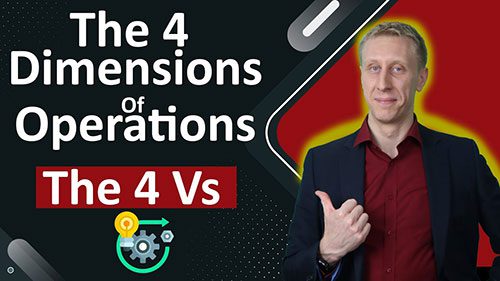Internal and External Objectives in Operations Management
Operations Management is difficult. The vast array of interacting variables and the diversity of possible objectives makes it full of decisions, trade-offs, prioritization all whilst doing your best to appease a wide range of stakeholders from customers to owners, workers, colleagues, regulators, the community and the environment.
However, in this article we will narrow that down to the 2 main groups of objectives for an operations manager. Internal and External Objectives
Prefer the Video Version?
Watch My YouTube Mini Videos on Internal and External Objectives:
“Operations Management A-Z” – My 3-hour introductory video training course
The difference between internal and external objectives of operations management.
The key difference between these objectives pertains to who they cater to. External objectives are all about what “customers” want from the operations. On the other hand, internal objectives refer to what the business “owners” want from the operations.
Internal Objectives are those given to the operations from within the organization – from the owners of the business or the shareholders / investors who demand operations performance for overall, profit-generating financial success.
External Objectives are what the “Customers” of the operations care about. These are totally different demand placed upon the operations and whilst ultimately satisfying customers is a pretty important part of a sustainably successful business, the things that a customer care’s about from the performance of the operations are very different.
DISCOVER THE “FORGOTTEN FUNDAMENTALS” OF OPERATIONS MANAGEMENT”
“External” Objectives in Operations Management – What the “Customer” wants
Below are 5 core external objectives of operations
- Quality: Doing the right thing to a standard, doing what was promised to be done / delivered, whether that is in the form of a service or a product. That can mean meeting the promised minimum requirements, or it can be providing premium quality and going above and beyond your requirements.
- Delivery: Ensuring that the service or product is delivered in a timely fashion and that new products are developed at an appropriate pace. Furthermore, it also refers to the modes of delivery, providing a range of delivery solutions to the clients.
- Flexibility: Providing customers with a range of services and products as well as customization options. This point inevitably touches on the company’s ability to adapt to customer demand.
- Service: The quality of service the company provides and how responsive it is to its customers. Basically, every contact point with a customer needs to produce a positive interaction.
- Cost: From the customer’s perspective, this is price. Clearly the costs the business operations incur in delivering a product / service are a key factor in the price that is possible to offer and customers are always seeking lower prices.
“Internal” Objectives in Operations Management – What the owners/ investors want
5 key internal operational objectives:
- More output: As long as there is demand, more output will lead to more sales, more revenue and typically more profit.
- Minimize operating expense: The fewer raw materials, energy and labor used to generate the desired output the better. Reducing operating expenses reduces the overall cost of delivery allowing for increased profit margins.
- Minimal investment: The profit an organization is capable of generating each year need to be kept in perspective to the size of the investment that has to be made to deliver it. Keeping working capital and capital investments low is a core objective for the owners / investors. This includes money tied up in equipment, buildings, and inventory that enables the desired output.
- Maximize flexibility: The ability to scale capacity up or down, the flexibility of labor contracts, and the commitments to suppliers and customers. Markets change, competition changes, anything can change and being flexible to ramp-up or down or pivot direction is a valuable capability to the owners / investors.
- Minimize risk: Complying with all appropriate regulations that affect the business, health and safety, etc. Any possible issue that could cause a problem, and become a headache for the senior managers or owners. Always a trade-off against other objectives such as inventory investment, newer equipment, increased operating expense though safety procedures and quality control – minimizing risk of expensive potential issues is still of great value to the owners / investors who would bear the cost should the risk become a reality.
Summary of Goals and Objectives in Operations Management
Operations Managers have many different objectives to juggle. The two main categories are “External” and “Internal”.
External objectives are demanded by the customers, basically getting a better product, faster, with more options, at lower cost with better service.
“Internal” objectives are all about what the “owners / investors” want from the business operations. Higher output, lower cost, lower investments, more flexibility, and less risk. Easy, right…!!!!
This is just one of the many topics covered in my introductory course to Operations Management
“Operations Management A-Z”, a 3 hour introductory course to give you solid grounding in the essentials of business operations management, whatever industry you work in – manufacturing, retail, transport or professional services.
Level up your business operations fundamentals. Check it out HERE!
Crack On!








